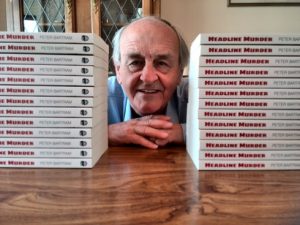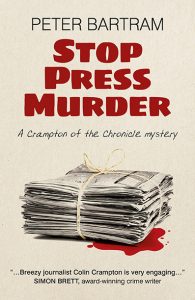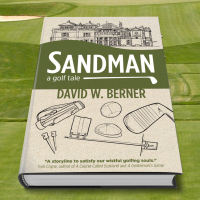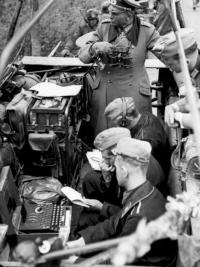
[caption id="attachment_1620" align="alignleft" width="300"] Author Peter Bartram[/caption]
Author Peter Bartram[/caption]
The author of the Crampton of the Chronicle crime mysteries talks to us about his roller-coaster career and latest book, and gives his advice on how to creating a winning plot.
Tell us about yourself.
I've been a writer and journalist all my working life. I sold my first story to a national newspaper when I was 18. Wrote my first book – strictly speaking, ghost-wrote for a well-known MP – when I was 21 and at university. And it's all been downhill ever since! Seriously, it's been a thoroughly enjoyable roller-coaster of a life. My work as a journalist has taken me to places I'd never otherwise have visited. I've pursued stories in places as diverse as 700-feet down a coal mine and a courtier's chambers in Buckingham Palace. And, along the way, I've written thousands of newspaper and magazine articles and 21 non-fiction books before turning to crime and penning the first of the Crampton of the Chronicle mysteries, Headline Murder, which was published last year.
Can you tell us about your next book?
 Stop Press Murder, the second in the Crampton series, is out in August. The series is set in Brighton in the 1960s – the Swinging
Sixties. Our hero, Colin Crampton, is the crime reporter on a local evening paper, the Evening Chronicle. He's in cut-throat competition with Jim Houghton, his rival on the Evening
Argus. So when Jim scoops Colin after a murder on the Palace Pier – the victim's body found in the coconut shy – Colin has to find a way to solve the murder so that he can grab the final big
headlines. The book is a "romp" in the tradition of classic crime capers of the 1960s, such as The Italian Job and The Thomas Crown Affair. There are several mysteries which Colin
has to solve, lots of action – and plenty of laughs along the way.
Stop Press Murder, the second in the Crampton series, is out in August. The series is set in Brighton in the 1960s – the Swinging
Sixties. Our hero, Colin Crampton, is the crime reporter on a local evening paper, the Evening Chronicle. He's in cut-throat competition with Jim Houghton, his rival on the Evening
Argus. So when Jim scoops Colin after a murder on the Palace Pier – the victim's body found in the coconut shy – Colin has to find a way to solve the murder so that he can grab the final big
headlines. The book is a "romp" in the tradition of classic crime capers of the 1960s, such as The Italian Job and The Thomas Crown Affair. There are several mysteries which Colin
has to solve, lots of action – and plenty of laughs along the way.
What do you think makes a great character?
It's a character readers want to spend time with. Character lies at the heart of all books – but that's especially true of a series. You need to find a character that can remain fresh in several books. When I was creating Colin Crampton, I knew he was going to be a bit of a rogue, but I tried to make sure he was likeable. He’s got a cheeky sense of humour and dry line in wisecracks. He'll pull any scam to get a story – but he fights on the side of the good guys. I’ve been interested in how some early readers have described Colin in their reviews. “I became very fond of our reporter as he got up to all kinds of mischief,” said one. “Colin is very likeable and plausible,” said another. “Colin is crafty, likeable and clever,” added a third. And that master craftsman of the cozy mystery, Simon Brett, has provided a cover quote for Stop Press Murder in which he says: "Breezy journalist Colin Crampton is very engaging." So it looks as though the lad may have a fan club, after all.
What do you think makes a great plot?
In a crime mystery, it’s a story with some well-defined characters which works at a number of levels. There will be a central mystery – which is the one that is finally resolved towards the end of the book. But, then, there will be smaller mysteries which are solved as the story progresses. In other words, like real life there are several different things happening all at the same time, but being resolved in different ways at different times. I write my books to entertain people. When I started my aim was to write the kind of book that someone would enjoy reading while they were sitting round the pool on holiday. (Or, even, in it – if the book could be printed on waterproof paper!)
Where do you get inspiration from?
That's the question that writers get asked most often – and it’s probably the most difficult to answer. I think every writer gets their ideas in their own way. There’s not some kind of formula you can apply. In my case – and remember I’m writing crime mysteries – it starts by asking a question. (The old journalism training coming in – journalists need to be adept at asking questions.) So, in the case of Headline Murder I asked: what would happen if somebody committed a murder, somebody else was blamed for it, but then a few years later something was going to happen that would point the finger at the true killer? Of course, that’s just the bare bones of an idea. You then need to think of ways to build it into a satisfying story. And that's when the really hard work starts.
Where do you write?
In my office. One wall is lined with books – a lot of them about the craft of writing. One contains a window where I look out across the garden. A third is bare. And the fourth has a picture of 100 Chinese characters. Apparently, the Chinese have 100 ways of writing the idea of "longevity" or "long life". My daughter Catherine saw these painted on a remote part of the Great Wall of China and her husband Barney took a photo and framed it for me. I think their message is that they want me to keep on writing for a few years yet.
Buy the paperback of Headline Murder – AMAZON US AMAZON UK INDIEBOUND
Buy the ebook of Headline Murder – AMAZON US AMAZON UK INDIEBOUND
Download a free Crampton of the Chronicle book, Murder in Capital Letters, at www.colincrampton/free-novella
Categories:
0 comments on this article







